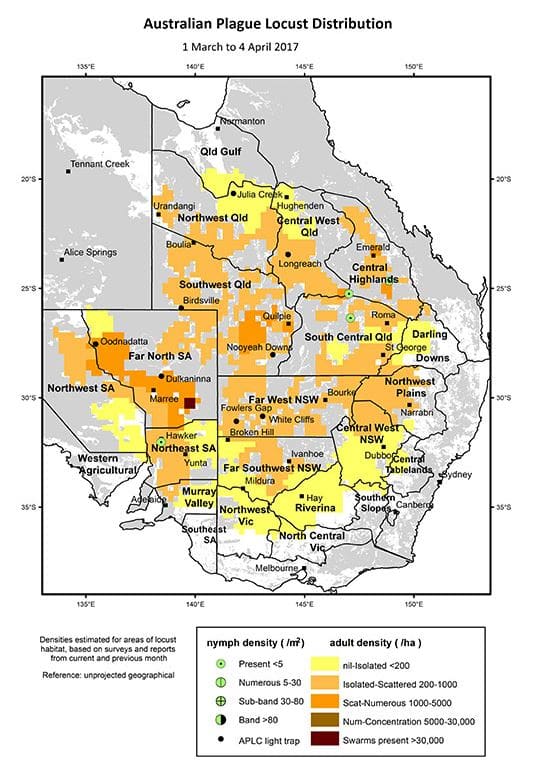AUSTRALIAN plague locust populations remained at low densities in most regions during March, according to the latest report from the Australian Plague Locust Commission.
However, medium density adult populations were maintained in the far north region of South Australia and in parts of south west Queensland, as a result of breeding in late January.
 Several small swarms were recorded in the North Flinders Ranges area of South Australia in late March. Few nymphs were recorded during March, indicating only limited egg laying during February. Habitat conditions in these regions are now mostly unsuitable for autumn breeding.
Several small swarms were recorded in the North Flinders Ranges area of South Australia in late March. Few nymphs were recorded during March, indicating only limited egg laying during February. Habitat conditions in these regions are now mostly unsuitable for autumn breeding.
The Commission expects there is unlikely to be significant numbers of nymphs in any region during April or May.
The outlook for the remainder of autumn is for locust population densities to remain generally low in most regions of NSW and Queensland.
Adult numbers are likely to decline to low densities in the far north, north east and western agricultural north west regions of South Australia during April and May.
The probability of migrations within South Australia will decline by May, but some southward movements are possible in April. Medium density populations could breed in parts of the north east and western agricultural regions.
The majority of eggs laid during April in all regions will be at low densities and will remain in diapause dormancy during winter.
There is a low probability of swarm infestations in any state during autumn. Consequently, there is a low risk of widespread nymph infestations developing in agricultural regions during spring.
For spur-throated locusts, a widespread medium density population was recorded throughout inland Queensland during February and March, with a relative decline in breeding adult and nymph numbers detected in some regions.
There were also widespread, low and medium density nymphs in central west and north west Queensland, and similar populations are likely in to be the Queensland Gulf region. Low density nymphs were recorded in the south west and south central regions. There is a low risk of a large increase in overall population level during 2016–17.
Low numbers of migratory locust adults were recorded south of Emerald in Queensland’s Central Highlands and north of Roma in south central Queensland in early March.
Source: Australian Plague Locust Commission
Full report: http://www.agriculture.gov.au/SiteCollectionDocuments/animal-plant/locusts/locust-bulletin-april2017.pdf



HAVE YOUR SAY